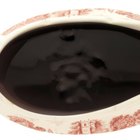
Depending where you were raised, you might think of gravy either as a heavy and fatty afterthought to the main meal, or as practically a food group in its own right. If you fall into the second category, you're probably already partial to sausage gravy. It's traditionally made in the same pan as the sausage, so the drippings can infuse it with their flavor. Some form of milk or cream is mandatory, with whipping cream making the richest and silkiest gravy.
Starting in the Skillet
When you finish cooking sausage patties or individual sausage links in your skillet, two things will be left behind. One is the cooking juices from the pork or beef in your sausage, in the form of a browned-on layer sticking to your skillet. The browning is important, because it's a natural process that creates intensely savory flavors out of the relatively bland meat juices. The second thing left behind is a pool of fat, something most diners would ordinarily avoid. But you need a certain amount of fat to make a traditional-style gravy. It's cooked together with flour to make a thickener, called a roux.
Stirring the Roux
A modest batch of gravy, making perhaps 2 cups, requires two to three tablespoons each of fat and flour. If you have more than the necessary amount of fat in the skillet you can drain the excess, or alternatively you can add oil to make up the amount you need. If you're willing to trade a bit of flavor for a reduction in saturated fat, pour away all the sausage drippings and replace them with unsaturated vegetable oil. As you stir the flour and fat together, the fat coats the flour particles, helping them stay lump-free when you mix up the gravy. This pre-cooking also takes most of the starchy flavor from the flour.
Bringing the Cream
Once your roux has cooked to an evenly pale gold color, and the starchy smell of the flour has given way to a rounded, nutty tone, it's time to add your cream. Pour the cold cream into your hot roux in a thin stream, whisking it briskly with a wire whisk or a fork. Whisking disperses the roux throughout the cream, helping spread the thickener evenly. It also helps dissolve the browned-on sausage juices from the bottom of the pan so they can lend their color and flavor to the gravy. Continue stirring for eight to 12 minutes, until the gravy has fully thickened.
At the Table
Once the gravy has thickened and no longer has any noticeable starchy taste, it's done. Taste it and adjust the seasonings as necessary, then pour it into a tall, thin measuring cup and keep it warm for a few minutes while any excess fat rises to the surface. Spoon that off, or if you have an old-fashioned gravy separator, use it to skim fat from the surface of the gravy as you fill your serving dish or gravy boat. Serve the gravy with sausage and biscuits, or any other side dishes that are traditional in your family.
Related Articles

How to Make Homemade Gravy With a Roux ...

How to Slow Cook a Joint of Beef

How to Use Leftover Marinade in Gravy

Why Does Cream Turn Into Butter?

Can You Substitute Cream of Mushroom ...

How to Make Country Gravy Taste Less ...

Adding Corn Starch to a Pot Roast

How to Make Cottage Cheese Lasagna

Cornstarch vs. Flour in Shepherd's Pie

How to Cook Chorizo in the Oven

How to Cook Vegetables With Progresso ...

How to Remove Fat From Soups and Sauces

How to Skim Grease in Sauce

How to Cook Beef Stew in the Oven

How to Make Gravy From Gravy Mix

How to Make Simple Homemade Gravy

What Is a Braising Pan?
How to Cook Beans & Soup Bones in a ...
How to Make Homemade Gravy

What Is Ratio for Cornstarch & Water to ...
References
- Professional Cooking; Wayne Gisslen
- Fine Cooking: How to Make and Use a Roux
Resources
Writer Bio
Fred Decker is a trained chef and prolific freelance writer. In previous careers, he sold insurance and mutual funds, and was a longtime retailer. He was educated at Memorial University of Newfoundland and the Northern Alberta Institute of Technology. His articles have appeared on numerous home and garden sites including GoneOutdoors, TheNest and eHow.
Photo Credits
Jupiterimages/Stockbyte/Getty Images